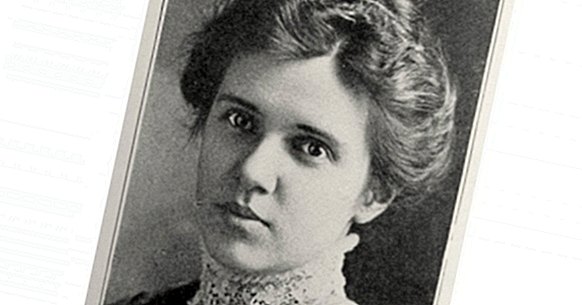Jessie Taft: biography of this referent of symbolic interactionism
Jessie Taft (1882-1960) was a pioneering philosopher and sociologist in symbolic interactionism , the women's movement and the discipline of Social Work. However, these contributions are often dismissed as being more recognized for having made important translations of the works of psychoanalysts Otto Rank and Sigmund Freud.
In addition, Taft belongs to a generation of women scientists who faced multiple forms of exclusion and professional segregation, among other things as a result of the strong rejection of the assimilation of female values in the public sphere, reserved exclusively for men.
She was also one of the women who integrated the School of Women of Chicago and approached from the perspective of the social conscience the booms of the movement of the woman, putting emphasis in the psychological conflicts by which they crossed the scientific women of the time.
In this article we will follow the work done by García Dauder (2004; 2009) to approaching the life and work of Jessie Taft through a brief biography , paying attention both to their theoretical contributions and to the social context in which they were developed.
- Related article: "History of Psychology: authors and main theories"
Biography of Jessie Taft: a pioneer of Social Work
Jessie Taft was born on January 24, 1882 in Iowa, United States. She was the oldest of three sisters, the daughters of a businessman and a mother who was a housewife. After having studied the institute at Drake University in Des Moines, Iowa; He studied higher education at the University of Chicago.
In the latter he trained with George Mead, a sociologist known for having laid the foundations of symbolic interactionism and who participated as his thesis director. Likewise he was trained in the pragmatist tradition of the Chicago School .
In the same context, Taft met Virginia Robinson, a woman with whom she adopted two children and who was his life partner for more than 40 years. Among the many subversive phrases that she contributed, Jessie Taft said that in America, where businesses are mutinying over culture, it was not unusual to find the single woman seeking company and refuge in another woman with whom to build bonds of similar criteria and values , difficult to find in a husband (Taft, 1916).
On the other hand, the doctoral thesis work that Jessie Taft did in the same context had the name of "The Women's Movement from the Point of View of Social Consciousness" (The movement of women from the point of view of social conscience) , where problematized the tensions between the private and the public , paying attention to how the political, economic and social transformations had formed the "self", especially in relation to the conflicts that women face at home and at work.
- Related article: "Symbolic Interactionism: what it is, historical development and authors"
The Hull House and the beginnings of Social Work
Founded in the year 1889 by Jane Addams and Ellen Gate Starr, the Hull House social center became a meeting place for many women (several social reformers and scientists who came from the University of Chicago). Soon they generated an important network of contacts and collaboration.
Said network resulted a qualitative and quantitative research work that is recognized as the Women's Sociological School of Chicago , and that, among other things, important impacts not only American sociology, but also the social and legislative situation, for example on the issue of social and racial inequalities, immigration, health, child labor and labor exploitation.
At the same time, this was a context of important social transformations generated by industrial capitalism. The women of the Chicago School, along with some well-known sociologists, such as Mead, Dewey, William Isaac Thomas, and others, questioned the strong androcentrism that marked the discipline and recognized the need to expand both the participation of women and the presence of female values in the public space.
Meanwhile, and to the opposite side, the management and access to higher education was marked by a segregation both sexual and disciplinary , which means that there were "junior" schools destined only for women, whose objective was to stop the growing feminization of university students.
Likewise and in the disciplinary field, sociology gave part of its contents to a new school, which also relapsed most of the reform work and political content that the School of Women of Chicago had been developing. This school was "Social Work" . And it was precisely in this context that Jessie Taft was displaced from sociology to Social Work, and later inaugurated a school known as "clinical sociology".
Among other things, the aforementioned had the consequence of displacing the values of the feminine to the activities related to the new and later undervalued discipline, Social Work; and the values of the masculine towards the academic institution and the sociology that developed there. As a result, Jessie Taft and many other women scientists found it difficult to access positions as teachers or researchers in different universities.
Social Work and clinical sociology
In the context of a reformatory for women in the state of New York, Jessie Taft was critical of considering that these women had "mental deficiencies", and argued that there could be a rehabilitation centered not so much on themselves, but on modify their environment and their living conditions . For example, trying to have sufficient economic resources or an adequate education.
These were the beginnings of "clinical sociology", which were later transferred to the social assistance of children with different difficulties and to the restructuring of adoption practices .
After facing different difficulties to access a job as both an intervener and a researcher in sociology, Jessie Taft joined the School of Social Work at the University of Pennsylvania, which among other things made her a leading woman in that discipline.
- Maybe you're interested: "The 10 essential women in the history of Psychology"
Symbolic interactionism and the women's movement
Jessie Taft argued that the women's movement (which was caused by an uneasiness that was becoming more and more evident), had its roots in a psychic conflict of this collective . They had desires for emancipation that they could not bring to the act because social conditions did not allow them.
He emphasized in an important way the need to make changes in a "social conscience" that promoted domestic individualism around a depersonalized industrial order .
When analyzing the social and economic transformations of industrial societies, Taft was very careful to detail how gender made the lived experiences different for men and women. This is how he argued that reforms could be carried out only when the "self" of each person became aware of the subjectivities and social relations that were being built in industrial societies.
Bibliographic references:
- García Dauder, S. (2009). Jessie Taft. Symbolic interactionism, feminist theory and clinical social work. Social Work Today, 56: 145-156.
- García Dauder, S. (2004). Conflict and social conscience in Jessie Taft. Athenea Digital, 6: 1.14.
- Taft, J. (1916). "The Women's Movement from the Point of View of Social Consciousness. Chicago: University of Chicago Press.
- The University of Chicago (2018). Ahead of her time. UChicago Magazine. Retrieved June 20, 2018. Available at //mag.uchicago.edu/education-social-service/ahead-her-time.



















